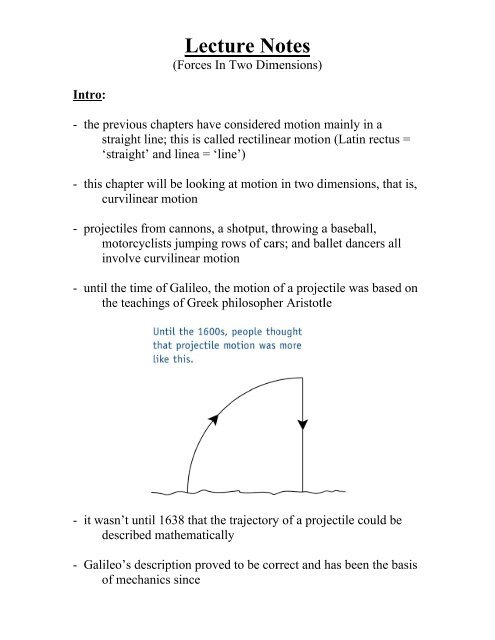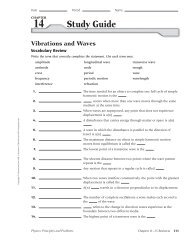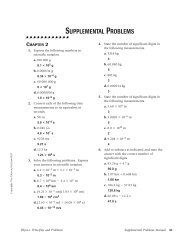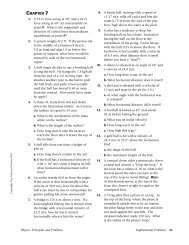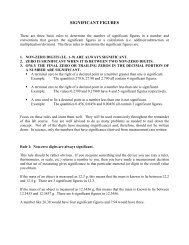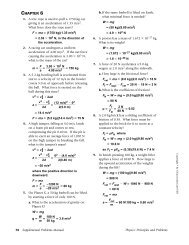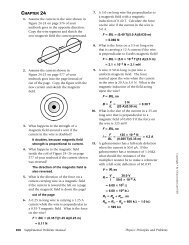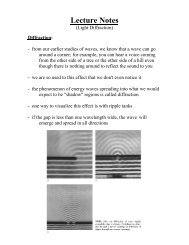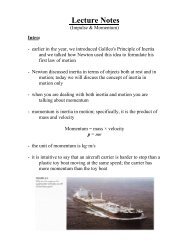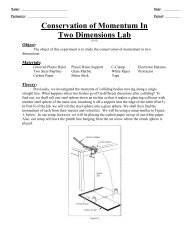Lecture Notes (Projectile Motion) - Dickey Physics
Lecture Notes (Projectile Motion) - Dickey Physics
Lecture Notes (Projectile Motion) - Dickey Physics
You also want an ePaper? Increase the reach of your titles
YUMPU automatically turns print PDFs into web optimized ePapers that Google loves.
<strong>Lecture</strong> <strong>Notes</strong>(Forces In Two Dimensions)Intro:- the previous chapters have consideredd motion mainly inastraightt line; thisis calledrectilinear motion (Latin rectus =‘straight’ and linea = ‘line’)- this chapter will be looking at motionin two dimensions, that is,curvilinear motion- projectilesfrom cannons, a shotput, throwing a baseball,motorcyclists jumping rows of cars; and ballet dancers allinvolvecurvilinear motion- until the time of Galileo, the motion of a projectile wasthe teachings ofGreek philosopher Aristotlebased on- it wasn’t until 1638 that the trajectoryof a projectile could bedescribed mathematically- Galileo’s description proved to be correct andof mechanics sincehas beenthe basiss
<strong>Projectile</strong> <strong>Motion</strong>:- good examples of projectilesare a rock thrownstraightthe top of a clifff and a ball thrownacross a fieldout from- the word projectile comes from the Latin jacere meaning ‘tothrow’ and pro meaning ‘forward’’- projectile motion can be separated into two components; avertical(up and down) motion anda horizontal motion- the verticalmotion is the same as discussed earlier, the ball isunder the influence of gravity andaccelerates at 9.8 m/s 2directedd downward (the negative direction)- inthe horizontal direction, there are no net forces actingon theobject so the velocity is constant- inall casess we are assumingair resistance is negligible- the path ofa movingobject is called its trajectory (Latintrajectusmeans ‘crossing’ or ‘passage’- a projectilee is an object that once given an initial thrust,it movesthroughh the air only under the force of gravity
Independence of <strong>Motion</strong> in Two Dimensions:- take a lookat the example above; we have twogolf ballsphotographed with a strobe light that flashed 30 times persecond- the ball on the right was given a horizontal velocity; theball onthe left was dropped; youcan see that the balls areaccelerated downward bythe force of gravity- note that the vertical positions of the two balls are the same ateach flash of thestrobe light; the horizontal positions differover time- the constant horizontal velocity and vertical accelerationproduces a trajectory thatt has the shape of a curve called aparabola
<strong>Projectile</strong>s LaunchedHorizontally:- projectileslaunchedhorizontally havee no initial verticalvelocity- asa result, the vertical motion is identical to that of a droppedobject- the downward velocity increases duegravityto the accelerationdue to<strong>Projectile</strong>s LaunchedVertically:- not all objects are thrown in a horizontal direction; cannonballs,footballs for example, areoften projected upward atan angle- tostudy projectile motion, we let θ bee the angle at which theobject is thrownrelative to the horizontal; this is called theelevation angle
- aiming wasvery much a hit-or-mistrajectory or eventhe angleof launch inaffair; there was noway ofdetermining theadvance- it wasn’t until self-taught engineer Niccolo Fontana publishedthe results of hisexperiments in 1546 that gunners realized a45° angle of elevation would give the maximum rangeAir Resistance:- air resistance has been left out of our discussions up to this point,but in the real world it plays a significant role in projectilemotion- for some streamlined, heavy objects, air resistance is minimal;but for other objects, it plays a large factor in the trajectory ofa projectile- the speed of an object also play a rolee in air resistance;thegreater the speedof an object the greater the air resistance


